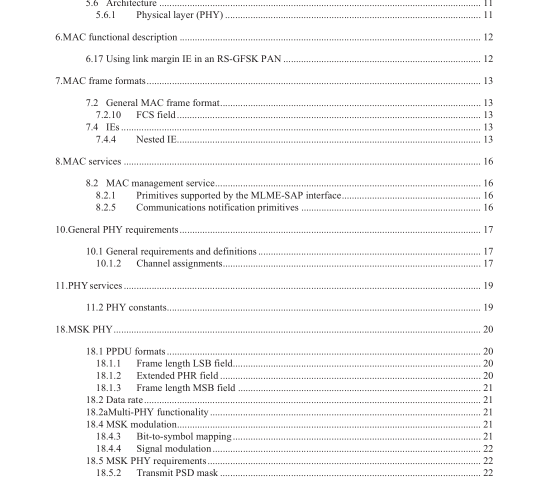IEEE 802.15.4t-2017 pdf download.IEEE Standard for Low-Rate Wireless Networks Amendment 4: Higher Rate (2 Mb/s) Physical (PHY) Layer
5. General description
5.6 Architecture
5.6.1 Physical layer (PHY)
Change the dashed list fllowing the scond paragraph of 5.6.1 as indicated:
Coexistence with other wireless standards has been analyzod for the PHYs defined in this standard. These analyses can be found in the following documents:
For the O-QPSK PHY, BPSK PHY, ASK PHY, Csss PHY, HRP UWB PHY, and GFSK PHY:
“Cocxistence analysis of IEEE Std 802.15.4 with other IEEE standards and proposed standards”
For the MSK PHY, with the sxcsption of the 2000 kb/s data rate. and the LRP UWB PHY:“TG4f Coexistence Assurance Document” [B17].
For the MSK PHY using the 2000 kh/s data ratc. “Csxistcnee Assuranes Document for 802.15.4” [BX].
For TVWS-FSK PHY, TVWS-OFDM PHY, and TVWS-NB-OFDM PHY: Chang and Seibert [B4].
For TASK PHY and RS-GFSK PHY: Nair et al. [B9b]-
6. MAC functional description
Change the title of 6.17 as indicated:
6.17 Using link margin IE i册anRS -GFSK PAN
Change the first and second paragraphs of 6.17 as indicated:
A device may include at RS -GFSK Link Margin IE within an enhanced acknowledgment. The RS -GFSK Link Margin IE shall only be transmitted as part of an Enh-Ack frame.
If a device receives an Enh-Ack frame containing att RS -GFSK Link Margin IE, it may adjust its transmit power within its power control range in all following GTS transmissions directed to the originating device.
The transmit power control shall ignore the RS -GFSK Link Margin IE when the device is transmitting nonGTS frames. If a device supports more than one data rate. a higher layer may use the information contained in the Link Margin IE to determine that the link margin is sufficient to support a higher data rate. The RSGFSK Link Margin IE is described in 7.4.4.32.
Change the fourth and fifth paragraphs of 6.17 as indicated:
The algorithm that controls the transmission of the RS -GFSK Link Margin IE and the algorithm that acts on the reception of the RS-GFSK-Link Margin IE are outside the scope of this standard.
If the security level, as described in 9.4.1.1, of the incoming Enh-Ack frame containing the RS -GFSKLink Margin IE is lower than that of the frame being acknowledged, then the RS GFSK Link Margin IE shall be ignored.
7. MAC frame formats
7.2 General MAC frame format
7.2.10 FCS field
Change the first paragraph of 7.2. 10, including breaking the paragraph into two separate paragraphs, as indicated, and add the following new paragraph:
The FCS field contains a 16-bit ITU-T CRC or a 32-bit CRC equivalent to ANSI X3.66-1979. The FCS is calculated over the MHR and MAC payload parts of the frame; these parts together are referred to as the calculation field.
Devices compliant with one or more of the SUN PHYs or TVWS PHYs shall implement the 4-0ctet FCS.
Devices compliant with the MSK PHY jimplementing the 2000 kb/s data rate shall implement both the 2-
octet and 4-octet FCS, as jindicated by the contents of the Extended PHR field described in 18.1.2. If the Extended PHR field is set to one, the 4-octet FCS shall be used; if the Extended PHR field is set to zero, the 2-octet FCS shall be used.
7.4 lEs
7.4.4 Nested IE
7.4.4.1 Format of nested IE
Change Table 7-16 as indicated (the entire table is not showm):
Change the title and first paragraph of 7.4. 4.32 and the title of Figure 7-101a as indicated:
7.4.4.32 RS GFSKLink Margin IE
The RS -GFSK Link Margin IE is optional and shall only be used in Enh-Ack frames that tuse the RSGFSKPHY. The IE Content field of the RS -GFSK-Link Margin IE shall be formatted as illustrated in Figure 7101a.
Figure 7-101a- RS -GFSKLink margin IE content field format
Change the equation in 7.4.4.32 as indicated:
Link Margin = Seeived – Ssensivity
where
Sreeived .
is the received power, in dBm, during a frame, as measured in the receiver.
Ssensitivity
is the reeeiver sensitivity as speeifed in 32.4.3 lowest input power required by the receiver, for the PHY that was used during the received frame. The conditions at which the lowest input power is determined are as follows: the packet error rate (PER) is 1%。and each packet in the PER measurement has a PSDU containing random data with a length of 250 octets.IEEE 802.15.4t pdf download.IEEE 802.15.4t-2017 pdf download
IEEE 802.15.4t-2017 pdf download

Leave a Reply